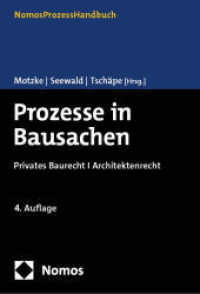- ホーム
- > 洋書
- > ドイツ書
- > Mathematics, Sciences & Technology
- > Medicine & Pharmacy
- > general survey & lexicons
Full Description
The new edition of this textbook provides uniquely comprehensive and nursing-focused coverage of family violence from an international perspective. Family violence is a global health crisis that impacts millions of people worldwide. As the world's largest and most trusted health profession, nurses play a unique and critical role in preventing, identifying, and mitigating family violence.
This textbook provides foundational knowledge on all aspects of family violence, presented in four main sections: What is Family Violence?; Family Violence and Nursing Practice; Family Violence across the Lifespan; Diverse Populations at Risk.
This resource is specific (but not exclusive) to nursing practice and outlines the importance of nurses in the prevention of family violence across the life course. It offers both practicing nurses and students a clear view of the essential theories, interventions, and issues surrounding nursing's role in addressing family violence - presenting an approach that empowers nurses to contribute to the prevention of this global health problem. Specific emphasis is placed on the co-production of research and practice improvements with survivors of family violence and the importance of multidisciplinary collaboration.
This new edition has a global perspective, with editors and family violence experts contributing from a range of countries and clinical settings like maternity, public and community health, forensic and paediatric nursing.
This easy-to-comprehend, yet detailed, overview of how nursing practice can reduce family violence and its associated health and social harms takes an intersectional and life course approach: from nursing care of the pregnant woman to the identification and management of elder abuse. An in-depth attention is brought to diverse populations at risk, including historically marginalized populations, sexual and gender minority communities, rural and remote populations, First Nations/Indigenous communities, people with disabilities, and migrant and refugee communities.
Contents
1. Defining Family Violence.- 2. Current and Evolving Theories and Frameworks Applied to Family Violence .- 3. Drivers and Consequences of Family Violence.- 4. Researching Family Violence.- 5. Public Health Nursing Approaches to Family Violence.- 6. First-Line Nursing Practices to Identify and Respond to Family Violence.- 7. Family Violence and Nursing Education.- 8. Legal and Ethical Issues.- 9. Addressing the burden of bearing witness: Multilevel responses to the trauma and violence experienced by nurses.- 10. Violence in Childhood.- 11. Family Violence in Adolescence and Emerging Adulthood.- 12. Understanding the Impact of Family Violence During Pregnancy.- 13. Intimate Partner Violence and Nursing Practice.- 14. Family Violence-Related Mortality.- 15. Health Inequities for Historically Marginalized Populations .- 16. Nursing Care for Family Violence among LGBTQ+ People.- 17. Rural and Remote Populations.- 18. Family Violence in Indigenous Communities.- 19. Violence against Persons with Disabilities.- 20. Family Violence in Migrant and Refugee Communities.







